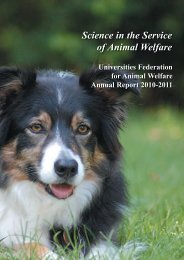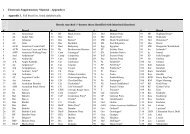Further evidence for the post-release survival of hand-reared ...
Further evidence for the post-release survival of hand-reared ...
Further evidence for the post-release survival of hand-reared ...
You also want an ePaper? Increase the reach of your titles
YUMPU automatically turns print PDFs into web optimized ePapers that Google loves.
28 Kelly et al<br />
Table 1 Characteristics <strong>of</strong> radio-tracked bats.<br />
Species Sex Ring number Admission weight (g) Release weight (g) Forearm length (mm) Condition index<br />
Common F Z3283 2.7 5.2 31.4 0.17<br />
Common F Z3288 2.9 6.0 32.4 0.19<br />
Common F Z2945 2.7 4.5 30.1 0.15<br />
Common M Z3255 2.2 4.3 27.5 0.16<br />
Common M Z3259 2.6 5.1 31.0 0.16<br />
Soprano F Z3263 1.9 4.8 30.2 0.16<br />
Soprano F Z3278 1.4 5.2 31.7 0.16<br />
Soprano F Z2939 2.3 5.1 31.6 0.16<br />
Soprano M Z3251 1.9 4.9 30.8 0.16<br />
Soprano M Z3281 2.3 4.8 32.2 0.15<br />
Condition index was calculated as bodyweight/<strong>for</strong>earm length.<br />
Figure 1<br />
<strong>release</strong> flight training in a large flight cage. More<br />
recently, Serangeli et al (2012) demonstrated <strong>post</strong><strong>release</strong><br />
<strong>survival</strong> <strong>of</strong> between four to 14 nights <strong>for</strong> 19 <strong>of</strong><br />
21 (90%) <strong>hand</strong>-<strong>reared</strong> Kuhl’s pipistrelles (Pipistrellus<br />
kuhlii) in Italy. They also demonstrated that <strong>the</strong> rehabilitated<br />
bats showed typical habitat use, <strong>for</strong>aging<br />
behaviour and were able to join existing roosts.<br />
In this paper, we add to <strong>the</strong> <strong>evidence</strong> that <strong>hand</strong>-<strong>reared</strong><br />
pipistrelle bats can survive independently in <strong>the</strong> wild,<br />
following rehabilitation. We radio-tracked a fur<strong>the</strong>r<br />
ten <strong>hand</strong>-<strong>reared</strong> pipistrelle bats (five common<br />
[Pipistrellus pipistrellus] and five soprano<br />
[Pipistrellus pygmaeus]) to measure <strong>the</strong>ir <strong>post</strong>-<strong>release</strong><br />
<strong>survival</strong>. In addition, we present data on six ringed bats<br />
sighted alive following <strong>release</strong> in bat boxes at <strong>the</strong> <strong>release</strong><br />
site, demonstrating longer-term <strong>survival</strong>.<br />
Pipistrelle bat showing C ring.<br />
Photograph© RSPCA Photo Library.<br />
Materials and methods<br />
All <strong>of</strong> <strong>the</strong> bats in this study were admitted in from disturbed<br />
or abandoned roosts as non-independent juveniles, ranging<br />
in weight from 1.4 to 2.9 g. All bats required <strong>hand</strong>-rearing<br />
(see Kelly et al 2008 <strong>for</strong> protocol). Once fully grown and<br />
able to fly, <strong>the</strong> bats were allowed to exercise freely in an<br />
outdoor flight cage (see Kelly et al 2008 <strong>for</strong> details) prior to<br />
<strong>release</strong> and roosted in a bat box fitted to <strong>the</strong> wall <strong>of</strong> <strong>the</strong> cage.<br />
The bat boxes were made <strong>of</strong> untreated wood, measuring<br />
25 × 19 × 19.5 cm (height at back × width × height at front<br />
to allow <strong>for</strong> sloped ro<strong>of</strong>) and consisted <strong>of</strong> a sloping, hinged<br />
lid <strong>for</strong> easy access and a back board carved with 1-mm<br />
grooves and a 1.5-cm gap <strong>for</strong> <strong>the</strong> bats to access by.<br />
Radio-tracking<br />
Ten bats were fitted with 0.35-g radio transmitters in late<br />
August/early September 2007, using <strong>the</strong> same methods as in




